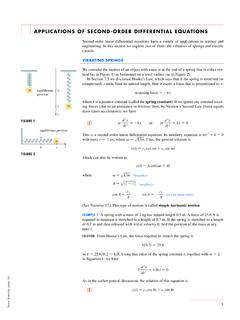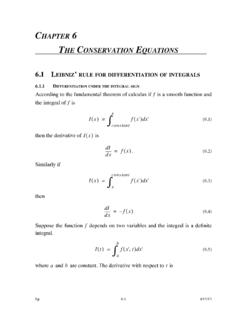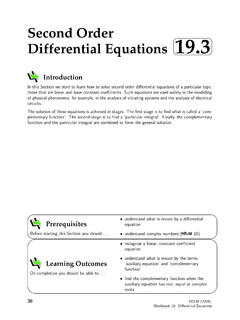Transcription of Ordinary Differential Equations and Dynamical Systems
1 Ordinary Differential Equations and Dynamical Systems Gerald Teschl This is a preliminary version of the book Ordinary Differential Equations and Dynamical Systems published by the American Mathematical Society (AMS). This preliminary version is made available with the permission of the AMS and may not be changed, edited, or reposted at any other website without explicit written permission from the author and the AMS. Author's preliminary version made available with permission of the publisher, the American Mathematical SocietyTo Susanne, Simon, and JakobAuthor's preliminary version made available with permission of the publisher, the American Mathematical SocietyAuthor's preliminary version made available with permission of the publisher, the American Mathematical SocietyContentsPrefacexiPart 1.
2 Classical theoryChapter 1. Introduction3 Newton s equations3 Classification of Differential equations6 First order autonomous equations9 Finding explicit solutions13 Qualitative analysis of first- order equations20 Qualitative analysis of first- order periodic equations28 Chapter 2. Initial value problems33 Fixed point theorems33 The basic existence and uniqueness result36 Some extensions39 Dependence on the initial condition42 Regular perturbation theory48 Extensibility of solutions50 Euler s method and the Peano theorem54 Chapter 3. Linear equations59 The matrix exponential59 Linear autonomous first- order systems66 Linear autonomous Equations of ordern74viiAuthor's preliminary version made available with permission of the publisher, the American Mathematical SocietyviiiContents General linear first- order systems80 Equations of ordern87 Periodic linear systems91 Perturbed linear first order systems97 Appendix: Jordan canonical form103 Chapter 4.
3 Differential Equations in the complex domain111 The basic existence and uniqueness result111 The Frobenius method for second - order equations116 Linear Systems with singularities130 The Frobenius method134 Chapter 5. Boundary value problems141 Introduction141 Compact symmetric operators146 Sturm Liouville equations153 Regular Sturm Liouville problems155 Oscillation theory166 Periodic Sturm Liouville equations175 Part 2. Dynamical systemsChapter 6. Dynamical systems187 Dynamical systems187 The flow of an autonomous equation188 Orbits and invariant sets192 The Poincar e map196 Stability of fixed points198 Stability via Liapunov s method200 Newton s equation in one dimension203 Chapter 7. Planar Dynamical systems209 Examples from ecology209 Examples from electrical engineering215 The Poincar e Bendixson theorem220 Chapter 8.
4 Higher dimensional Dynamical systems229 Attracting sets229 The Lorenz equation234 Author's preliminary version made available with permission of the publisher, the American Mathematical SocietyContentsix Hamiltonian mechanics238 Completely integrable Hamiltonian systems242 The Kepler problem247 The KAM theorem249 Chapter 9. Local behavior near fixed points253 Stability of linear systems253 Stable and unstable manifolds255 The Hartman Grobman theorem262 Appendix: Integral equations268 Part 3. ChaosChapter 10. Discrete Dynamical systems279 The logistic equation279 Fixed and periodic points282 Linear difference equations285 Local behavior near fixed points286 Chapter 11. Discrete Dynamical Systems in one dimension291 Period doubling291 Sarkovskii s theorem294 On the definition of chaos295 Cantor sets and the tent map298 Symbolic dynamics301 Strange attractors/repellors and fractal sets307 Homoclinic orbits as source for chaos311 Chapter 12.
5 Periodic solutions315 Stability of periodic solutions315 The Poincar e map317 Stable and unstable manifolds319 Melnikov s method for autonomous perturbations322 Melnikov s method for nonautonomous perturbations327 Chapter 13. Chaos in higher dimensional systems331 The Smale horseshoe331 The Smale Birkhoff homoclinic theorem333 Melnikov s method for homoclinic orbits334 Author's preliminary version made available with permission of the publisher, the American Mathematical SocietyxContentsBibliographical notes339 Bibliography343 Glossary of notation347 Index349 Author's preliminary version made available with permission of the publisher, the American Mathematical SocietyPrefaceAboutWhen you publish a textbook on such a classical subject the first ques-tion you will be faced with is: Why the heck another book?
6 Well, everythingstarted when I was supposed to give the basic course onOrdinary Differen-tial Equationsin Summer 2000 (which at that time met 5 hours per week).While there were many good books on the subject available, none of themquite fitted my needs. I wanted a concise but rigorous introduction with fullproofs also covering classical topics such as Sturm Liouville boundary valueproblems, Differential Equations in the complex domain as well as modernaspects of the qualitative theory of Differential Equations . The course wascontinued with a second part onDynamical Systems and Chaosin Winter2000/01 and the notes were extended accordingly. Since then the manuscripthas been rewritten and improved several times according to the feedback Igot from students over the years when I redid the course. Moreover, since Ihad the notes on my homepage from the very beginning, this triggered a sig-nificant amount of feedback as well.
7 Beginning from students who reportedtypos, incorrectly phrased exercises, etc. over colleagues who reported errorsin proofs and made suggestions for improvements, to editors who approachedme about publishing the notes. Last but not least, this also resulted in achinese translation. Moreover, if you google for the manuscript, you can seethat it is used at several places worldwide, linked as a reference at varioussites including Wikipedia. Finally, Google Scholar will tell you that it iseven cited in several publications. Hence I decided that it is time to turn itinto 's preliminary version made available with permission of the publisher, the American Mathematical SocietyxiiPrefaceContentIts main aim is to give a self contained introduction to the field of or-dinary Differential Equations with emphasis on the Dynamical Systems pointof view while still keeping an eye on classical tools as pointed out first part is what I typically cover in the introductory course forbachelor students.
8 Of course it is typically not possible to cover everythingand one has to skip some of the more advanced sections. Moreover, it mightalso be necessary to add some material from the first chapter of the secondpart to meet curricular second part is a natural continuation beginning with planar exam-ples (culminating in the generalized Poincar e Bendixon theorem), continu-ing with the fact that things get much more complicated in three and moredimensions, and ending with the stable manifold and the Hartman third and last part gives a brief introduction to chaos focusing ontwo selected topics: Interval maps with the logistic map as the prime ex-ample plus the identification of homoclinic orbits as a source for chaos andthe Melnikov method for perturbations of periodic orbits and for findinghomoclinic only requires some basic knowledge from calculus, complex functions,and linear algebra which should be covered in the usual courses.
9 In addition,I have tried to show how a computer system,Mathematica, can help withthe investigation of Differential Equations . However, the course is not tiedtoMathematicaand any similar program can be used as AMS is hosting a web page for this book updates, corrections, and other material may be found, including alink to material on my own web site: ~gerald/ftp/book-ode/There you can also find an accompanyingMathematicanotebook with thecode from the text plus some additional do not put aAuthor's preliminary version made available with permission of the publisher, the American Mathematical SocietyPrefacexiiicopy of this file on your personal webpage but link to the wish to thank my students, Ada Akerman, Kerstin Ammann, J orgArnberger, Alexander Beigl, Paolo Capka, Jonathan Eckhardt, Michael Fis-cher, Anna Geyer, Ahmed Ghneim, Hannes Grimm-Strele, Tony Johansson,Klaus Kr oncke, Alice Lakits, Simone Lederer, Oliver Leingang, JohannaMichor, Thomas Moser, Markus M uller, Andreas N emeth, Andreas Pich-ler, Tobias Preinerstorfer, Jin Qian, Dominik Rasipanov, Martin Ringbauer,Simon R o ler, Robert Stadler, Shelby Stanhope.
10 Raphael Stuhlmeier, Ger-hard Tulzer, Paul Wedrich, Florian Wisser, and colleagues, Edward Dunne,Klemens Fellner, Giuseppe Ferrero, Ilse Fischer, Delbert Franz, Heinz Han -mann, Daniel Lenz, Jim Sochacki, and Eric Wahl en, who have pointed outseveral typos and made useful suggestions for improvements. Finally, I alsolike to thank the anonymous referees for valuable suggestions improving thepresentation of the you also find an error or if you have comments or suggestions(no matter how small), please let me have been supported by the Austrian Science Fund (FWF) during muchof this writing, most recently under grant TeschlVienna, AustriaApril 2012 Gerald TeschlFakult at f ur MathematikNordbergstra e 15 Universit at Wien1090 Wien, preliminary version made available with permission of the publisher, the American Mathematical SocietyAuthor's preliminary version made available with permission of the publisher, the American Mathematical SocietyPart 1 Classical theoryAuthor's preliminary version made available with permission of the publisher, the American Mathematical SocietyAuthor's preliminary version made available with permission of the publisher, the American Mathematical SocietyChapter Newton s equationsLet us begin with an example from physics.






